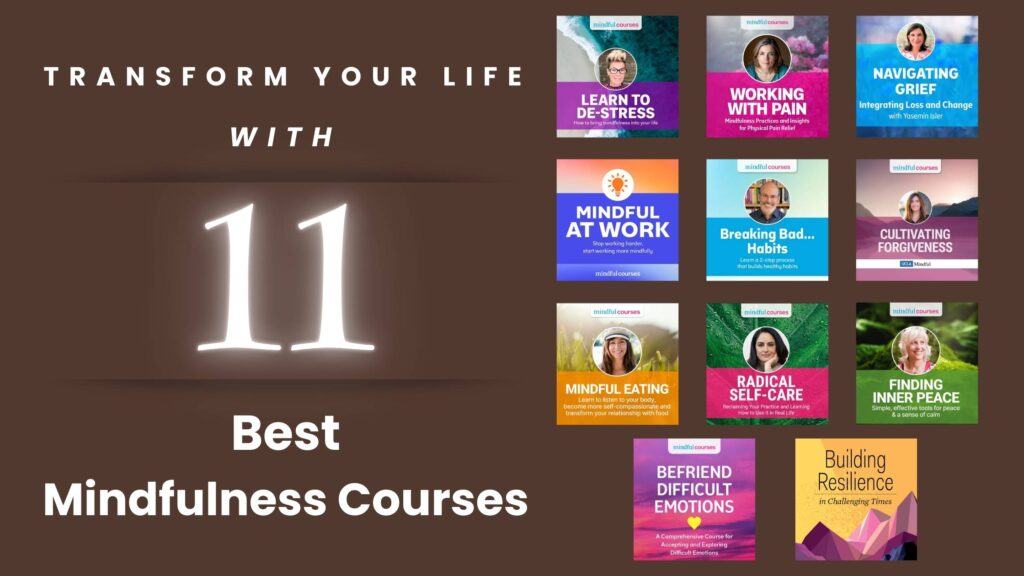What if you could bring more calm and clarity into your day without setting aside an hour to meditate? Mindfulness exercises for beginners don’t have to be long or complicated, in fact, some of the most effective ones can be done in under a minute.
In this post, you’ll discover seven simple, non-traditional mindfulness practices you can fit into everyday moments. Each one is designed to help you slow down, become more present, and reduce stress, even if you’ve struggled to stick with meditation before.
TL;DR: Mindfulness Exercises For Beginners
These 7 simple mindfulness exercises for beginners take just seconds to a few minutes and fit into daily life:
- STOP Technique (Mindful Pausing)
- Mindful Transitions Between Tasks
- Ambient Sound Listening
- Sentence Stem Journaling
- Using Your Non-Dominant Hand
- Scent-Anchor Breathing
- 30-Second Nature Glimpse
1. STOP Technique (Mindful Pausing)
Sometimes the most powerful way to be mindful is simply to stop. The STOP technique is a quick mental pause that can help you break out of autopilot and respond more calmly to whatever is happening.
What STOP Stands For:
- S – Stop: Pause whatever you’re doing for a moment.
- T – Take a breath: Inhale deeply and exhale slowly. Let your body relax a little.
- O – Observe: Notice what’s happening in your body, thoughts, and surroundings. Are your shoulders tense? Is your mind racing?
- P – Proceed: Move forward with more awareness and intention, rather than rushing or reacting.
Why This Works:
We often react without thinking, especially when stressed. This simple pause interrupts that pattern, giving your brain a chance to reset. Even 20–30 seconds of mindful pausing can lower tension and help you make better decisions.
When to Use It:
- Before answering a stressful email.
- During a heated conversation.
- When you feel overwhelmed or distracted.
- While waiting in line or sitting in traffic.
Quick Tip:
Set two or three reminders on your phone throughout the day that simply say “STOP.” Over time, it will become a natural habit to pause, breathe, and refocus.
2. Mindful Transitions Between Tasks
Switching from one task to another may seem quick, but our minds often carry leftover stress or thoughts from what we just finished. Mindful transitions give you a short moment to clear mental clutter before moving on.
Why It Matters:
When we jump straight from one activity to the next, like answering emails right after a meeting, our brains don’t get a chance to reset. This builds up tension and makes it harder to focus. Taking even 10–20 seconds to pause can refresh your mind and improve your next task’s quality.
How to Do It:
- When you finish a task, stop for a moment before starting the next one.
- Close your eyes if possible, or soften your gaze.
- Take two or three slow breaths, releasing the last task with each exhale.
- Set an intention for the next thing you’re about to do.
When to Try It:
- Before making a phone call after sending emails.
- After finishing household chores before sitting down to rest.
- When entering a new room or meeting.
Quick Tip:
If you struggle to remember, link this habit to something you already do, like placing your hands on your lap for a moment or stretching your arms before starting something new.
Hope you’re finding this post useful!
Want to take your mindfulness practice further? I have got some fantastic tools that could be just what you need. Give them a look and see how they can benefit you!



3. Ambient Sound Listening
You don’t always need silence for mindfulness, sometimes the sounds around you can be the perfect anchor for awareness. Ambient sound listening means focusing fully on the noises in your environment without judging or labeling them.
Why It Works:
Our minds often wander because we’re lost in thought. When you focus on sounds, you bring your attention into the present moment. This helps quiet mental chatter and creates a sense of calm, even in busy settings.
How to Do It:
- Sit or stand still for 30–60 seconds.
- Let your ears pick up on every sound, nearby and far away.
- Avoid labeling them as “good” or “bad.” Just notice them as they are.
- If your mind drifts, gently return to the act of listening.
When to Try It:
- While walking outdoors.
- During your commute.
- In a café, park, or waiting room.
- At home, listening to the hum of appliances, birdsong, or distant traffic.
Quick Tip:
If you’re in a noisy place, think of each sound as part of a “soundscape.” This makes it easier to accept all noises instead of resisting the ones you don’t like.
4. Sentence Stem Journaling
Sometimes mindfulness is easier when you have a starting point. Sentence stem journaling uses short, open-ended prompts to help you notice your thoughts, feelings, and surroundings without overthinking.
Why It Helps:
Blank pages can feel intimidating. A sentence stem gives your mind a gentle nudge, making it easier to focus on the present moment. It also helps you process emotions and observations in a structured way.
How to Do It:
- Choose a simple stem, such as:
- “Right now I feel…”
- “Today I noticed…”
- “One thing I’m grateful for is…”
- Write the first thing that comes to mind, without worrying about grammar or style.
- Stop when you feel done, even if it’s just one sentence.
When to Try It:
- First thing in the morning to set the tone for your day.
- During a lunch break to reset your mind.
- Before bed to reflect on your day.
Quick Tip:
Keep a small notebook or a notes app on your phone so you can journal anywhere. Even one sentence a day can build a powerful mindfulness habit over time.
If you’re ready to deepen your mindfulness practice, check this amazing tool that can help you get there!

Discover the Mindful Living Bundle – your essential toolkit for daily peace and presence.
With the Mindful Living Journal, you’ll build a meaningful five-minute daily practice that cultivates gratitude, centers your mind, and nurtures inner calm.
And with the Mindful Affirmations deck, infuse your day with powerful reminders of inner peace and growth. Embrace mindfulness every day with the Mindful Living Bundle today!
5. Using Your Non-Dominant Hand
One simple way to bring yourself into the present moment is to switch hands for everyday activities. Using your non-dominant hand forces your brain to pay closer attention because the action feels unfamiliar.
Why It Works:
We do most daily tasks on autopilot. By changing your routine, you disrupt that autopilot and naturally become more aware of your movements, sensations, and surroundings. This also engages different parts of your brain, improving mental flexibility.
How to Do It:
- Choose a small daily activity, like brushing your teeth, stirring tea, or unlocking your phone.
- Do it entirely with your non-dominant hand.
- Notice how it feels, any awkwardness, slowness, or extra effort.
- Stay present with the sensations instead of rushing through.
When to Try It:
- Brushing your teeth in the morning.
- Eating a snack.
- Pouring water into a glass.
- Opening doors or carrying a bag.
Quick Tip:
It will feel clumsy at first and that’s the point. That little bit of challenge keeps your attention here and now.
6. Scent-Anchor Breathing
Scents have a unique way of pulling us into the present moment. Scent-anchor breathing combines mindful breathing with a specific smell to create a calming, sensory cue you can return to anytime.
Why It Helps:
Smell is closely linked to memory and emotions. By pairing a pleasant scent with deep, slow breaths, you create a strong mental association with relaxation and presence. Over time, simply smelling that scent can help you feel calmer.
How to Do It:
- Choose a scent you find soothing, like lavender, chamomile tea, citrus peel, or fresh herbs.
- Hold it close enough to inhale gently.
- Take two or three slow, deep breaths, focusing on both the scent and the rhythm of your breathing.
- Let the aroma guide your attention away from distractions.
When to Try It:
- Before a meeting or presentation.
- During a stressful moment at work.
- As part of your bedtime routine.
- While taking a short break during the day.
Quick Tip:
Keep a small bottle of essential oil or a herbal tea bag in your bag or desk drawer so you can use this technique anywhere.
7. 30-Second Nature Glimpse
Even a short connection with nature can help you feel grounded and refreshed. A 30-second nature glimpse is a mini mindfulness break where you simply observe a natural element with your full attention.
Why It Works:
Nature has a calming effect on the mind and body. Focusing on something natural, like a plant, the sky, or sunlight, gives your mind a gentle pause from constant thinking and screen time.
How to Do It:
- Find something natural around you: a tree, flower, houseplant, cloud, or even the pattern of sunlight through a window.
- Spend 30 seconds observing it closely.
- Notice details you might normally miss, shapes, colors, textures, movements.
- If your mind wanders, gently bring it back to what you see.
When to Try It:
- Looking out the window during a work break.
- While walking outdoors.
- In your kitchen with a potted herb or fruit bowl.
Quick Tip:
If you live in a city, you can use a single leaf, a potted plant, or even the sky as your “nature moment.” The key is presence, not location.
Final Thoughts
Mindfulness doesn’t have to mean long meditations or strict routines. These seven exercises show that small, intentional moments can be just as powerful for building awareness and calm. You can try them anywhere, while working, resting, or moving through your day.
Start with one exercise that feels easy and repeat it for a few days. As it becomes more natural, explore the others and notice how they change the way you experience everyday life. Over time, these small moments of presence can add up to big changes in your focus, mood, and well-being.
Which of these mindfulness exercises will you try first?
Discover trusted programs that teach meditation and mindfulness in a practical, beginner-friendly way. Learn from some of the world’s best teachers and make meditation a lasting part of your daily life.



